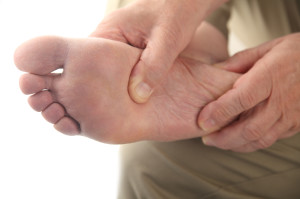 Diabetic ulcers are open wounds or sores usually found on the bottom of feet. These ulcers affect many people with diabetes and experts suggest that about 15 percent of diabetics will develop one or more at some point in their lifetime. Many of those with diabetic ulcers are hospitalized due to infections or other complications. In extreme cases, the infections require amputations. However, the development of diabetic foot ulcers is preventable so it is vital see a diabetes specialist immediately if any symptoms are present.
Diabetic ulcers are open wounds or sores usually found on the bottom of feet. These ulcers affect many people with diabetes and experts suggest that about 15 percent of diabetics will develop one or more at some point in their lifetime. Many of those with diabetic ulcers are hospitalized due to infections or other complications. In extreme cases, the infections require amputations. However, the development of diabetic foot ulcers is preventable so it is vital see a diabetes specialist immediately if any symptoms are present.
First signs of diabetic foot ulcers
• Numbness or loss of feeling in one or both feet
• Foot swelling, discoloration or warmth around the wound
• Toe or foot redness
• Drainage of fluid in socks or shoes
• Pain or firmness around the wound area
• Fever and chills in advanced stages of foot ulcers
Risk factors for diabetic foot ulcers
Anyone with diabetes is a risk of developing a diabetic foot ulcer. Here is a list of other risk factors that increase the chances for developing foot ulcers:
• Diabetes that is not well controlled
• Being overweight
• Neuropathy – a nerve disorder caused by both type 1 and type 2 diabetes.
• Poor circulation
• Wearing shoes that do not fit
• Walking barefoot
• Aging
• Excessive alcohol use
• Smoking
• High Cholesterol
How to avoid foot ulcers
• Those with diabetes should have their feet checked at least once a year by a healthcare professional. Catching the symptoms early can sometimes prevent diabetic foot ulcers.
• Inspect both feet every day, especially between the toes and the sole of the foot. Look for swelling, cuts, cracks, blisters, ulcers, redness or any other abnormalities. If any problems are found make an appointment to see a doctor as soon as possible.
• Always wear properly fitted shoes, preferably with thick soft socks. Ill-fitting shoes are involved in about half of the problems that lead to amputations.
• Never walk barefoot, even at home. Wear slippers while walking around the house.
• Wash feet once or twice daily with soap and dry them carefully. If skin is dry a moisturizing cream can be used daily but avoid getting it between toes.
• Do not wear anything constricting such as panty hose or knee-highs that will restrict circulation to the legs and feet.
• Do not wear sandals, high heels or any shoes with straps that go in between the toes.
• Keep toenails short. Cut the toenails straight across to avoid ingrown toenails.
Treatment for diabetic foot ulcers
Diabetes is the number one cause of foot amputations in the United States. Immediate treatment by a trained diabetes specialist or podiatrist is essential. When treated right away, acute diabetic foot ulcers can heal in a little as three to six weeks for people with good circulation. Deeper, chronic ulcers that were not treated as quickly can take several months to heal and might even need partial or full foot amputation.
Treatments generally begin with cleaning the area and removing the surrounding dead skin and tissue. Next, the wounds are dressed. Proper wound dressing aims to maintain a balanced, moist environment to allow the ulcer to drain and heal simultaneously. Both oral and topical medications are usually prescribed to treat and prevent further infections. It is recommended to keep weight off of the affected foot until it is fully healed. Sometimes non-removable casts are applied to help distribute weight and reduce healing times. It is imperative to keep blood sugar levels under control while healing. In worst case scenarios treatment may require an amputation.
OakBend Medical Center emphasizes the importance of early diagnosis and treatment of diabetic foot ulcers. Healing ulcers quickly will lower the risk of infection. OakBend Medical Center provides state-of-the-art therapy and advanced wound technology to diagnose and thoroughly treat diabetic ulcers. For more information please contact a trained Houston wound care specialist today by calling 281-341-3000.
What is a Diabetic Ulcer?
OakBend Medical Center © 2024 All rights reserved
